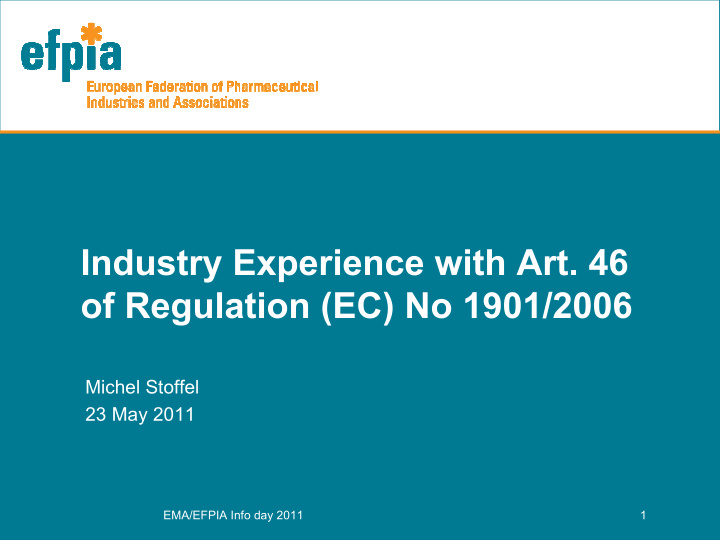



Industry Experience with Art. 46 of Regulation (EC) No 1901/2006 Michel Stoffel 23 May 2011 EMA/EFPIA Info day 2011 1
Article 46 procedures • 122 submissions by 31 companies to comply with Art.46 • For 13 (11%) submissions, assessment deferred because of planned future regulatory procedures (variations, line extensions) • High proportion of assessments finalised Progress with Art.46 assessment procedures (Number of procedures) Procedure started 39 Procedure finalised 23 0 5 10 15 20 25 30 35 40 EMA/EFPIA Info day 2011 2
Impact of Article 46 procedures • Based on 23 reported finalised Art.46 procedures, a low number of procedures have resulted in revised product information – Suggests start of more procedures should be deferred until additional data available? – Or suggests need to rethink the need for submission of paediatric trial results within 6 months of completion? Impact of finalised Art.46 procedures No impact on PI? 17 safety updates in PI 5 new paediatric use (indication and/or dosing) in … 1 deletion of a paediatric indication from PI 0 0 2 4 6 8 10 12 14 16 18 EMA/EFPIA Info day 2011 3
Company perceptions of Art.45 and 46 procedures Attribute Companies feedback (Selection of the 3 highest percentages) 32% Agree Overall, the procedure for appointment of the 32% Neither agree nor disagree Rapporteurs was satisfactory 6% Disagree or Strongly disagree 21% Agree Overall, the interaction with the Rapporteurs 29% Neither agree nor disagree was satisfactory 15% Disagree 12% Agree Overall, the total duration (from submission of data package to conclusion at European 32% Neither agree nor disagree level) of Article 45 and 46 Worksharing 21% Disagree Procedures was satisfactory EMA/EFPIA Info day 2011 4
European Vaccine Manufacturers’ difficulties with the implementation of Art. 46 EMA/EFPIA Info day 2011 5
Art. 46 timelines : realistic requirement? • Art. 46 requires submission of paediatric studies involving the use of an authorised product, within 6 months of completion • “Completion of study” is not defined in the Paediatric Regulation nor in the Clinical Trials Directive, however it is defined in: – Commission guideline [2008/C 243/01]: i.e. “Last Patient Last Visit” (LPLV) – Commission Guideline on Clinical Trial Applications [2010/C 82/10] : i.e. “The definition of the end of the trial should be provided in the protocol.” • Even for a “standard size” vaccine study in children it is impossible in practice to report in a 6-month time frame following LPLV EMA/EFPIA Info day 2011 6
Necessary steps between LPLV and finalisation of the clinical study report • Transfer of biological samples from study sites to laboratories for analysis • Sample testing (multiple tests needed, e.g. co- administration studies) • Data monitoring and cleaning • Statistical analysis • Study report writing • Obtaining the investigator’s signature EMA/EFPIA Info day 2011 7
A vaccine example • Sample (e.g. serology) testing is one of the lengthiest steps this step alone often takes more than 6 months • A standard vaccine co-admin. study in paed. population : – Prevenar 13 ™ + Infanrix hexa ™ with standard sample size of 500 subjects – blood samples are collected in two time-points (i.e. before vaccination and after the 3 rd dose) • Prevenar 13 ™ (13 antigens, 2 different assays needed) – ELISA for all subjects 500 x 2 time-points x 13 Ag = 13000 tests – OPA for half of subjects 250 x 2 time-points x 13 Ag = 6500 tests • Infanrix hexa ™ (10 antigens) – 500 subjects x 2 time-points x 10 antigens = 10000 tests • In total 29500 tests are needed EMA/EFPIA Info day 2011 8
Other situations that could also delay the study report submission • Outsourcing of study (e.g. to a CRO or a third party) adds complexity, and ultimately may delay the availability of the study report • In the case of a trial conducted in the US under a Written Request, a slow enrolment may lead to an FDA Written Request amendment, which should be available before data is submitted to FDA – Preference is to submit first (or at least in parallel) to Agencies to whom commitment is made, before Article 46 submission in EU EMA/EFPIA Info day 2011 9
Long-term solutions • Harmonise reporting requirements for all clinical trials to 12 months – EC Communication 2009/C28/01[*] recognises that 6 months may be too short and allows derogation to extend deadline to 12 months for objective scientific reasons (except in case of Art.46 trials) [*] EC Communication 2009/C28/01 on entering result related information into EudraCT (cfr. Art. 41) – No public health justification to apply different rules for paediatric studies – One common set of rules for all trials facilitates implementation into company compliance systems • Extensions beyond 12 months should be possible on a case-by-case basis if scientifically justified EMA/EFPIA Info day 2011 10
Possible short term solutions • Update definition of “study completion” in the following EC Guidelines in order to match timelines for Art.46 and EudraCT with practical reality: – EC Communication 2008/C 243/01 (Guideline on PIP format and content) – EC Communication 2009/C28/01 (Guideline on the paediatric trials information to be entered into EudraCT in accordance with Art. 41) • Align definition with the one given in EC Communication 2010/C 82/01 (Detailed guidance on trial authorisation and end), which says: “The definition of the end of the trial should be provided in the protocol.” • Delete exception for Art 46 trials to allow derogation for all trials, and make the 12 months deadline a standard rule • Allow possibility for company to send a letter to Authorities within 6 months to justify anticipated delays in study report submission • Practical solutions need to be found a.s.a.p. EMA/EFPIA Info day 2011 11
Recommend
More recommend